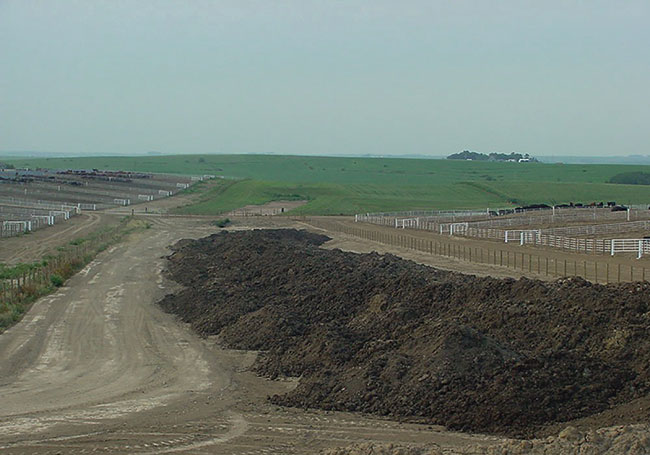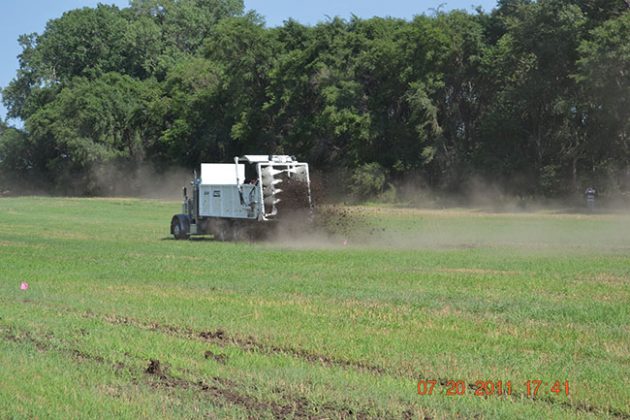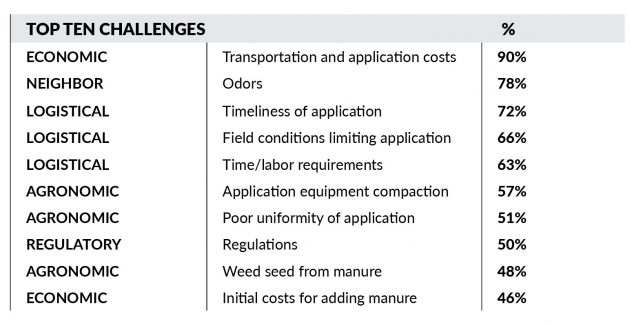
Features
Manure Management
Survey Says. . .
Results of a manure use survey show the barriers of manure use in cropping systems.
August 2, 2020 by Richard Koelsch
 Photo courtesy of Richard Koelsch.
Photo courtesy of Richard Koelsch. Animal agriculture is tasked with recycling the nitrogen (N) and phosphorus (P) in manures in an environmentally sound manner, typically as a soil fertility amendment. With feed supplies commonly originating from cropland that isn’t managed by animal feeding operations, this recycling requires that manures be transferred to crop farms with little or no history of manure.
A faculty team from University of Nebraska, University of Minnesota, and Iowa State University is addressing the need to expand the acreage receiving animal manures. The project team, with the guidance of a stakeholder advisory group of farmers and advisers, implemented a survey of perceptions of animal manure’s benefits and challenges. American Society of Agronomy’s (ASA) International Certified Crop Adviser (ICCA) Program, Manure Manager magazine, and others promoted this survey among farmers and their advisers.
The faculty team, including Daniel Andersen from Iowa State University, Erin Cortus and Melissa Wilson from the University of Minnesota, and Richard Koelsch, Leslie Johnson and Amy M. Schmidt from the University of Nebraska-Lincoln, surveyed 957 farmers and their advisers to understand their perceptions of the benefits and challenges of manure use in cropping systems. The key take-home messages included:
- A strong recognition of manure’s agronomic, yield, and soil health benefits exists, but there is little understanding of manure’s potential water quality benefits.
- Many challenges frequently become barriers to manure use. The most commonly identified barriers include transportation costs, odor, logistical barriers, and some agronomic questions. Help with these challenges is critical to expand the role of manure in fertility programs.
- Frequent users of manure recognize the complementary benefits of manure and fertilizer. Helping farmers employ these complementary roles will be critical to expanding manure’s use.
Who responded to the survey?
At publication time, responses had been received from 957 individuals from the U.S. and Canada, representing individuals who have a history of manure use. For example, 73 percent of farmers responding use manure annually. The results provide insight to manure’s benefits and challenges from frequent users, but do not represent the perspectives of crop farmers or advisors with no history of manure use.
Perceptions of manure’s benefits
Five characteristics identified as potential benefits by our project’s stakeholder advisory group were evaluated for survey participants’ perceptions and understanding.
The agronomic and yield effects of animal manures are commonly valued as beneficial and most believe they are very or moderately knowledgeable of these topics. Future educational and technical services may need to target in-depth topics, such as integrating manure and fertilizer for optimum crop response and estimating field specific economic benefits and transportation costs.
Farmers and their advisers both clearly recognize of the value of manure to soil physical and biological properties. However, the survey results showed mixed messages on the level of understanding of manure’s value to soil health, especially from farmers. Do farmers recognize these benefits but feel uncomfortable in communicating these benefits to others? Recent educational experiences that introduced farmers to three “soil health” measures for identifying preferred fields for manure revealed this to be universally new to farmers. Services connecting manure and soil health will be valuable.
Farmers and their advisers have a low opinion and understanding of manure’s benefits to water quality. Most agricultural audiences have experienced substantial negative press describing the water quality risks from manure, generally associated with its overapplication. The water quality benefits that accompany agronomic manure application rates are less well understood. Helping farmers and advisers recognize and discuss the water quality benefits of organic fertilizers should be a future focus.
We also learned that frequent users of manure recognize the complementary benefits of manure and fertilizer in their decisions or recommendations. Research supports this complementary role as the best opportunity for at least 10 percent yield increases, a strong argument for moving manure to fields with no manure history. Services that define the complementary fit for manure and fertilizer have an important future.

Photo courtesy of Richard Koelsch.
Perceptions of barriers to manure use
A wide range of challenges associated with animal manure use can prevent its acceptance for individual fields. Individual regions may need to further assess those regionally specific and audience-specific challenges to best target local needs. However, we would suggest that four common challenges must be addressed to avoid becoming barriers to manure use.
Transportation costs: The cost of transporting manure is the first barrier. Is this perception based upon an understanding of today’s costs and services available? Businesses providing manure hauling and land application services have greatly expanded in their availability and the ability to move large volumes across significant distances. The changes that have occurred in the last decade in terms of equipment and business services may suggest a need to re-assess how far manure can be hauled. It’s necessary to help farmers understand current costs and compare the nutrient value for individual fields. In addition, growing business services that broker and move manure will be important.
Odor: Farmers desire to be good stewards and good neighbors. The unhappy calls farmers receive from neighbors about manure odors is a significant barrier to expanding manure use. Options for incorporating manure should be considered. However, recognition that odors are a part of manure application, even with best practices in place, is crucial. Some are training farmers and manure haulers to recognize conditions that lead to air inversions and odor concentration at ground level. A weather forecast is a powerful tool to identify low-risk application times and locations, thus eliminating many odor nuisance calls.
Logistical barriers: A range of logistical challenges ranked near the top as common barriers to using manure, including three among the top five challenges. Timely manure nutrient application for agronomic needs when confronted with labor, equipment, and field condition restrictions is tricky business. No single solution will counter these challenges. Robust business services designed to facilitate brokering, transport and land application can help with timing challenges. Expanding the application window (e.g. growing season manure application options) presents additional flexibility for manure.
Agronomic issues: Manure application comes with a history of agronomic concerns, such as compaction, poor uniformity, and potential for weed seed and herbicide resistance concerns. Many agronomic issues are likely to be regionally and manure source-specific, thus the need to adapt to local needs. Education and business service strategies that address emerging precision manure application technologies, towed-hose manure application, designer manures, and composting may have value depending on local or regional needs.

TABLE 1 Twenty-three additional agronomic, rural community, economic, regulatory and logistical challenges (not shown here) were available to be selected.
Where do we go from here?
The next important environmental improvement for our management of animal manures will be revealed as we utilize more crop acres, often managed by a different business from our animal feeding operations, in the recycling of manure N and P. For this to occur, our team proposes that:
- Crop farmers and advisers need to recognize the agronomic, yield, soil health, and water quality benefits that can accompany the use of manure.
- Solutions need to be found for the top ten challenges identified above, plus other locally specific concerns.
- Rural communities should recognize the importance of recycling manure N and P. Communities that grow corn and other animal feeds should be a part of agriculture’s circular economy.
The authors wish to thank Manure Manager magazine, the ASA ICCA program, The Fertilizer Institute, and our many partners in Iowa, Minnesota, and Nebraska for promoting this survey. The current survey, requiring less than 10 minutes to complete, remains open for additional responses at http://go.unl.edu/manure.